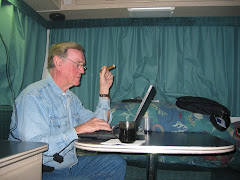
OUR CAMEL, RINGEE
Excerpted from my book OUR SUMMER IN AUSTRALIA Amazon.com
Day Twelve. Alright, this is the last day of the journey, so, how about a desert sunrise camel ride, or more factually; a dromedary ride of the one humped type.
ALL ABOUT THE CAMELS. The camel ride was not at all an inane tourist attraction, and I came away with a great respect for these animals. They were very instrumental in the development of early Australia. Initially brought in from Northern India, they immediately proved their value in the hot and dry interior of the country. Able to travel for 300-400 km without water, while carrying five times their weight, they were ideal for tasks such as bringing water to parched miners and hauling large quantities of wool from ranches — some over a thousand from miles from the nearest port. They served as pack animals for expanding the railroads into the interior, and pulled wagons and carriages more efficiently than horses. Some camels have been recorded as going over 650km (400 miles) and two weeks without water. Their demands are small — they can graze on most anything, unlike the horse. They can even drink salt water with no ill effect. After six or eight days of steady work, they need a day’s rest, and then they’re ready to move on. When water becomes available they will fill up with a 100 or so liters, which they can swallow in just a few minutes. They have a long life, well beyond 25 years, if well treated. They’re noted for a discerning personality, for if they don’t like you they will soon let you know by biting or peeing on you. Yet they are very loyal, forming lifelong companionships with other camels and drivers, from which they don’t like to be separated. They are communal animals, and do best with several more camels around them.
CAMELS IN AUSTRALIA. The Australians soon learned it was better to employ drivers that knew how to handle these independently minded animals. They brought in hundreds of Afghans, or in strine, “Ghans,” (that actually were from present day Pakistan) to manage the growing herds. So numerous were the Ghans in the 19th century, one still occasionally comes across a 19thcentury mosque, such as the one I saw in Broken Hill; a poignant reminder of the deep faith of Muslims. Eventually, with the railroad, improved highways, and finally the automobile, the need for camels decreased, and they were turned loose into the vast interior wilderness. That was wonderful! What a great retirement home —natural habitat, no predatory enemies, and best of all, no drivers or work. The cameleers, now without employment and in an alien country, by and large returned to their homeland, but some descendants remain in the outback today.
Presently, Australia has more wild camels than any other country, exports live camels, and camel meat has recently been approved for export. The camel population is increasing, but so far there is no cause for alarm, as they have little harmful effect on the land, in terms of over grazing, or invading inhabited areas. There are no reliable figures, but one government estimate has about 600,000 wild camels enjoying one helluva good time out there!
NEXT POSTING: Our Camel, Ringee, and an amusing camel story.
